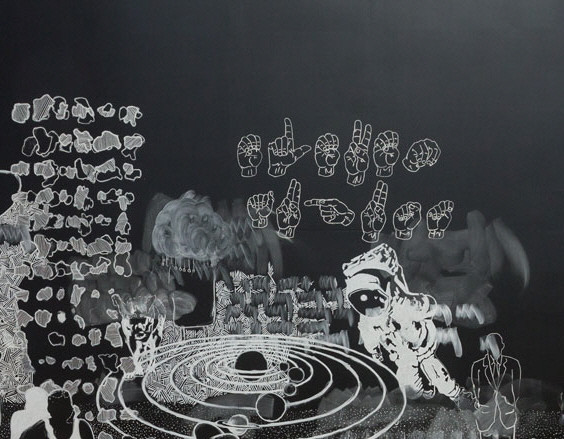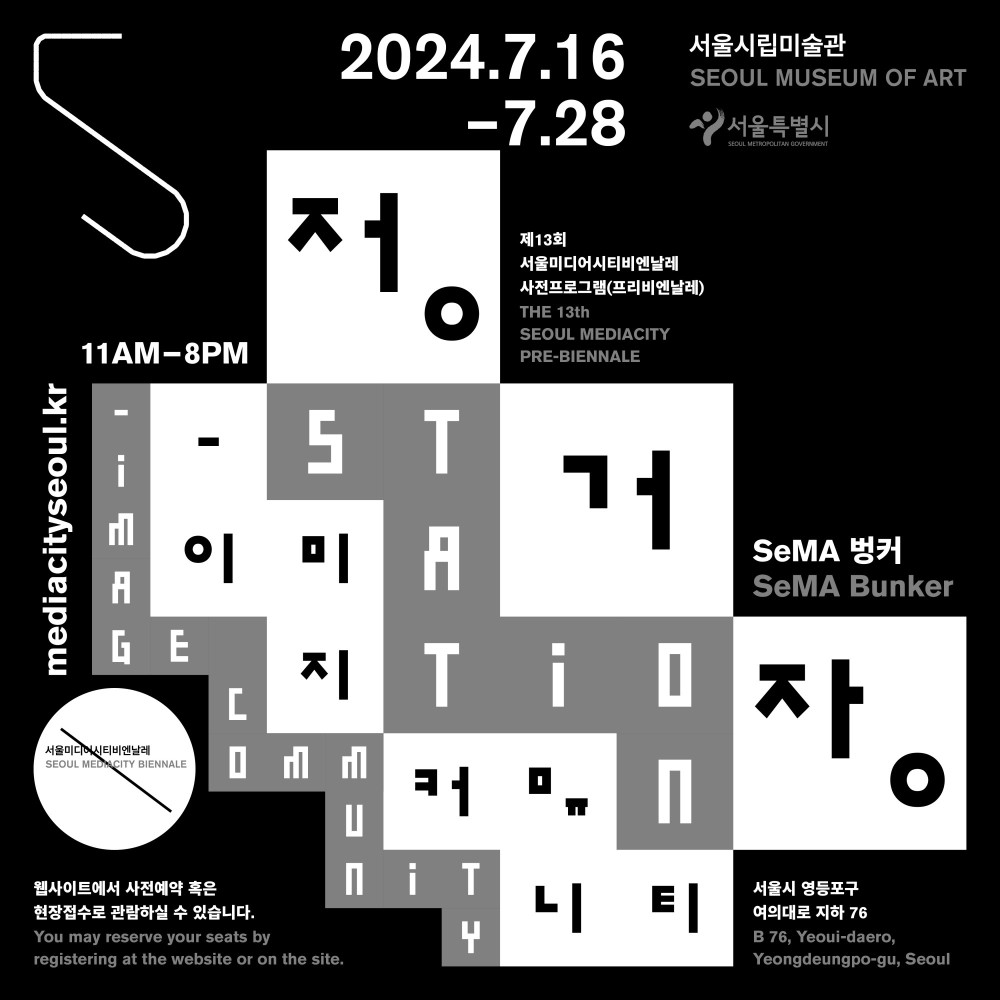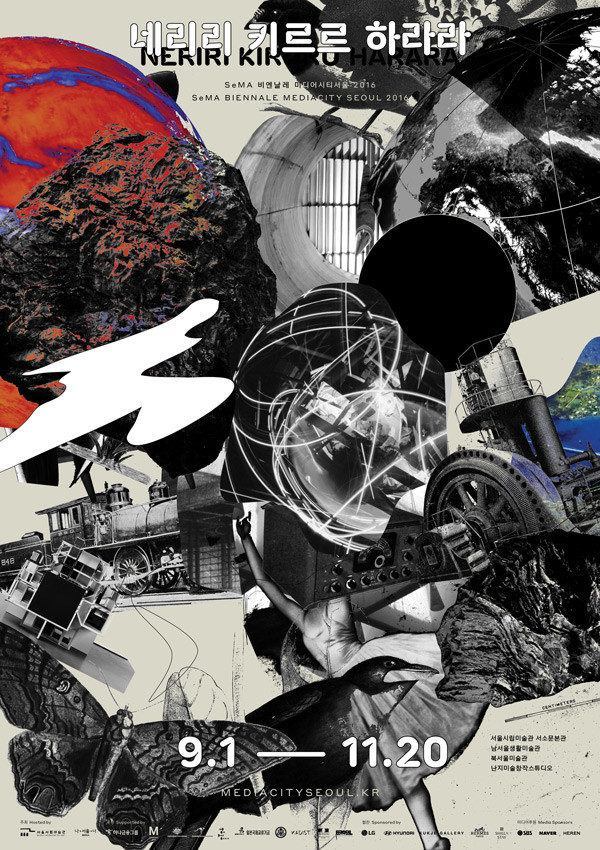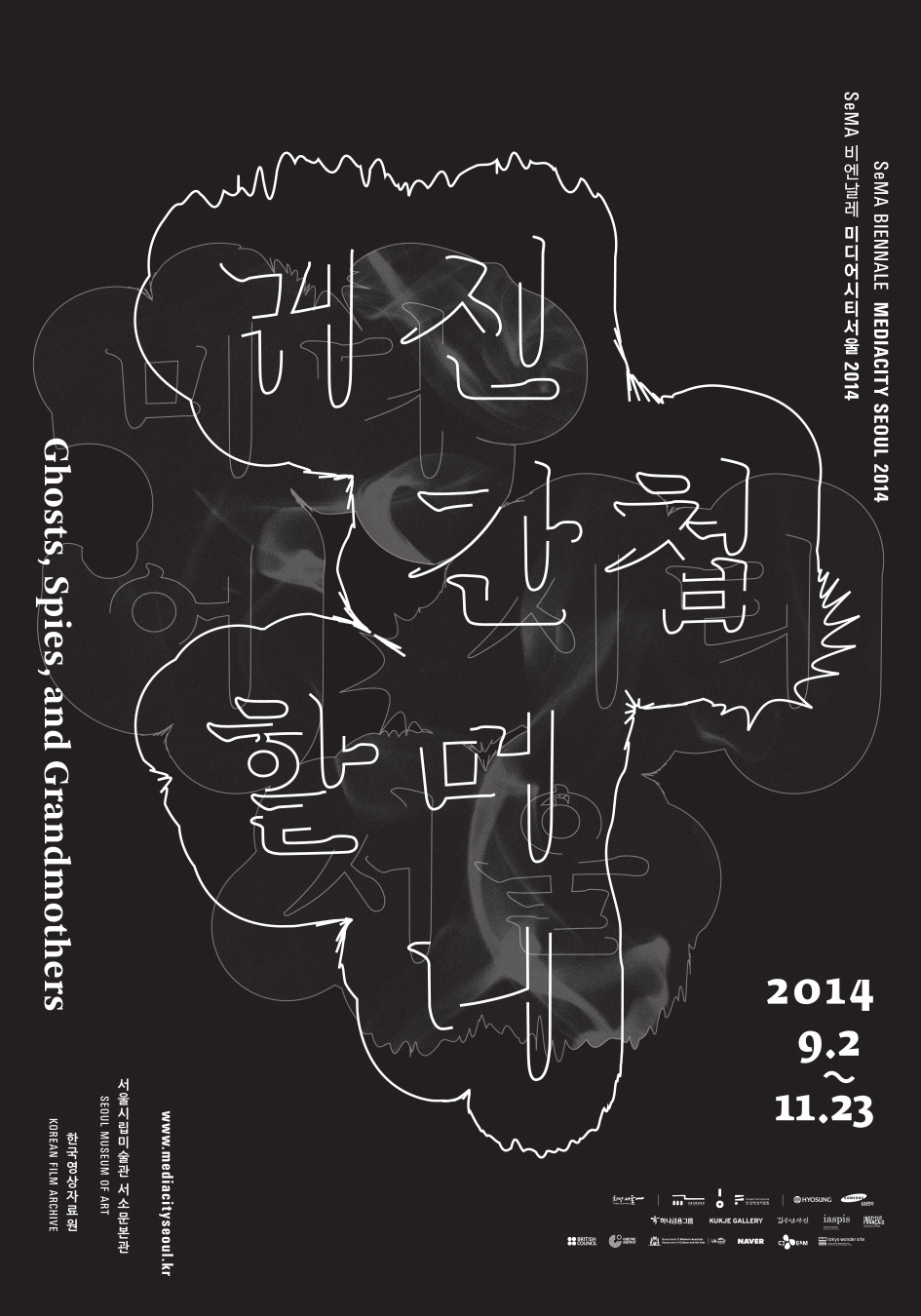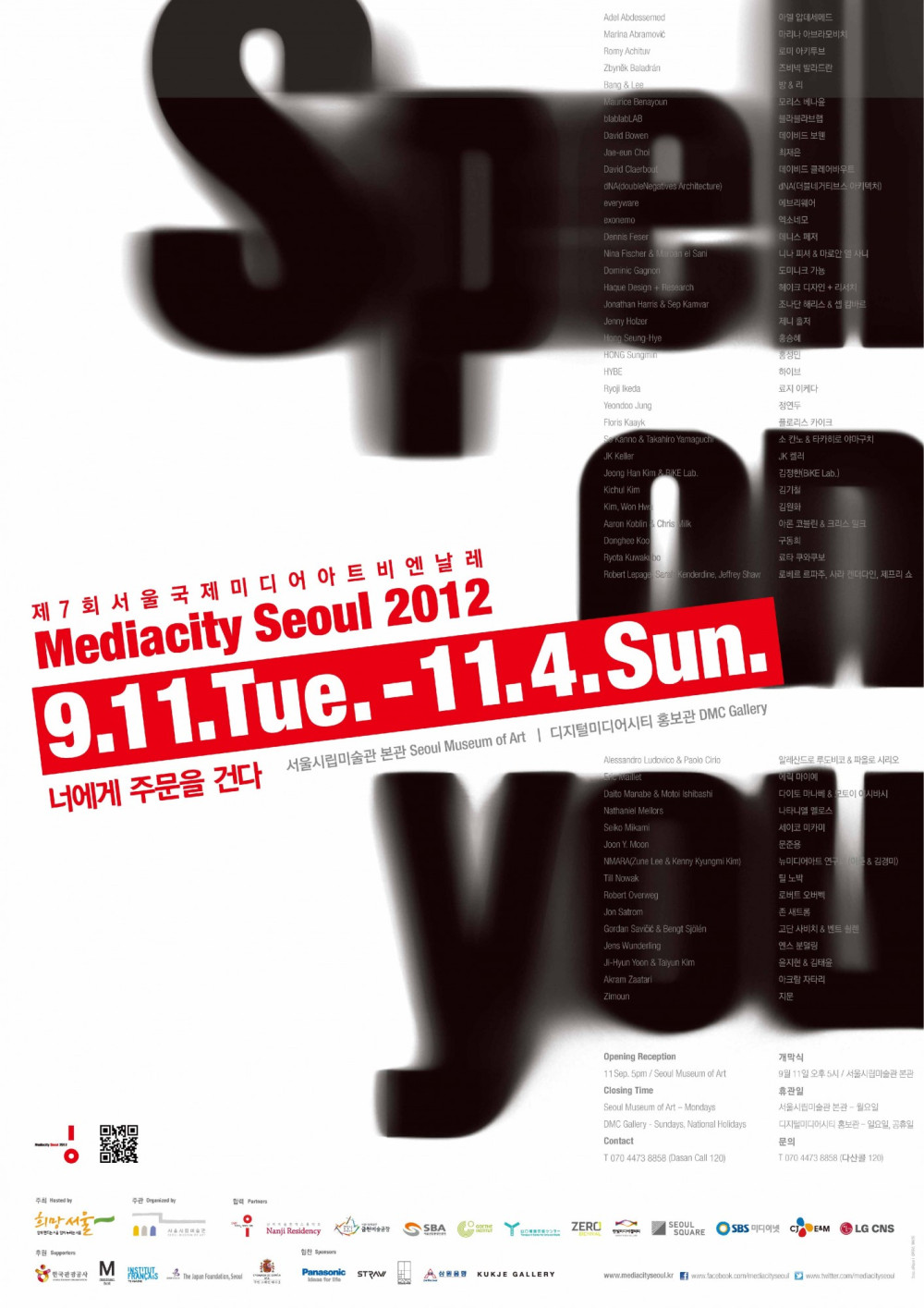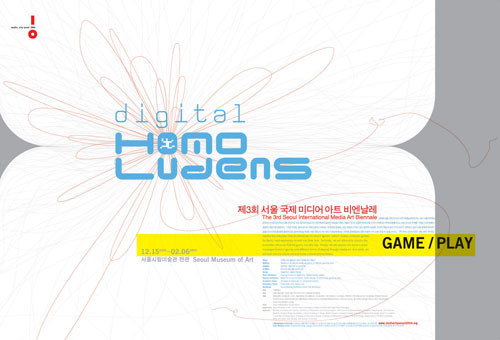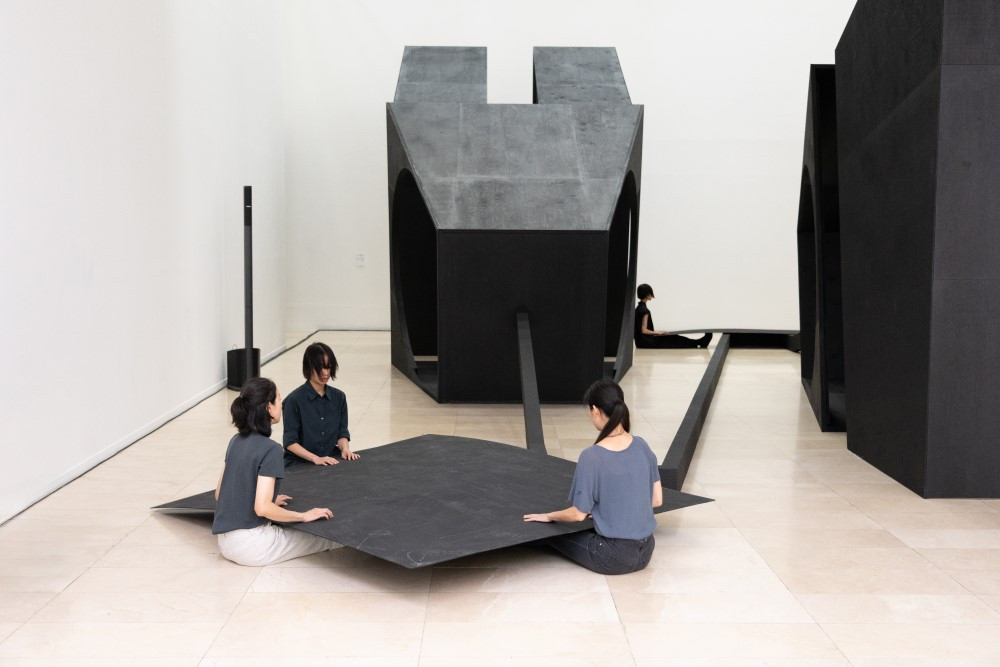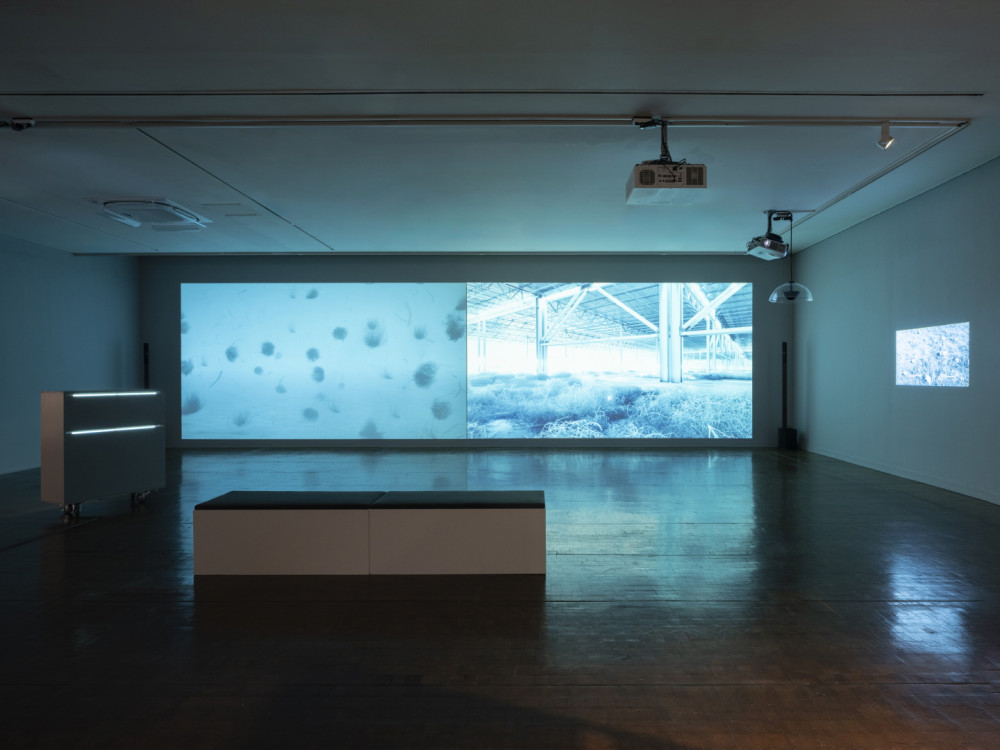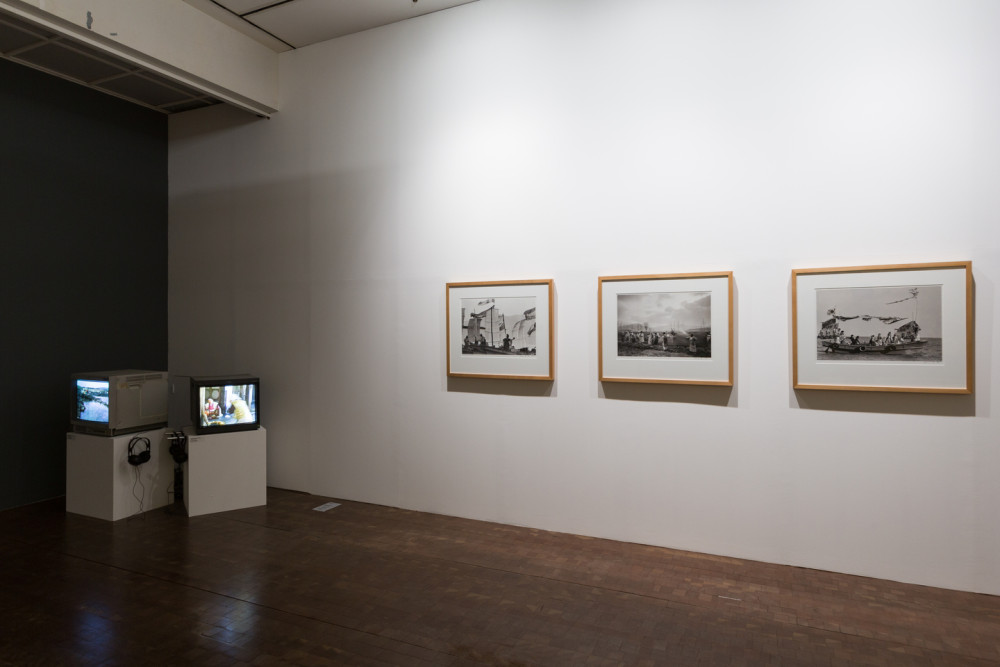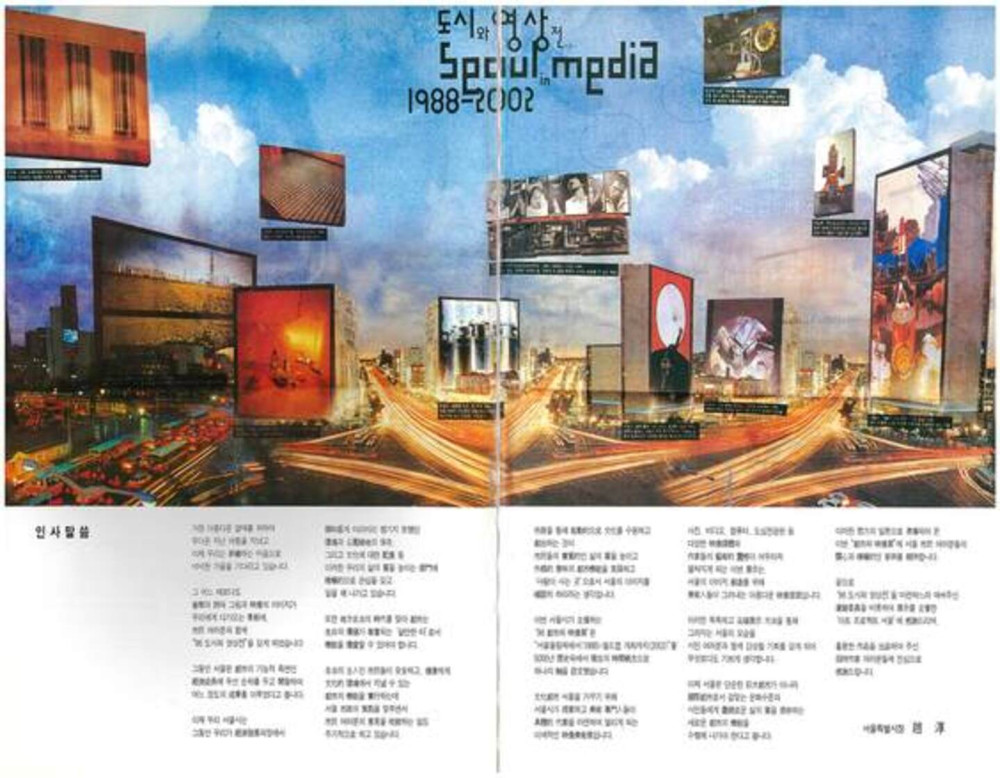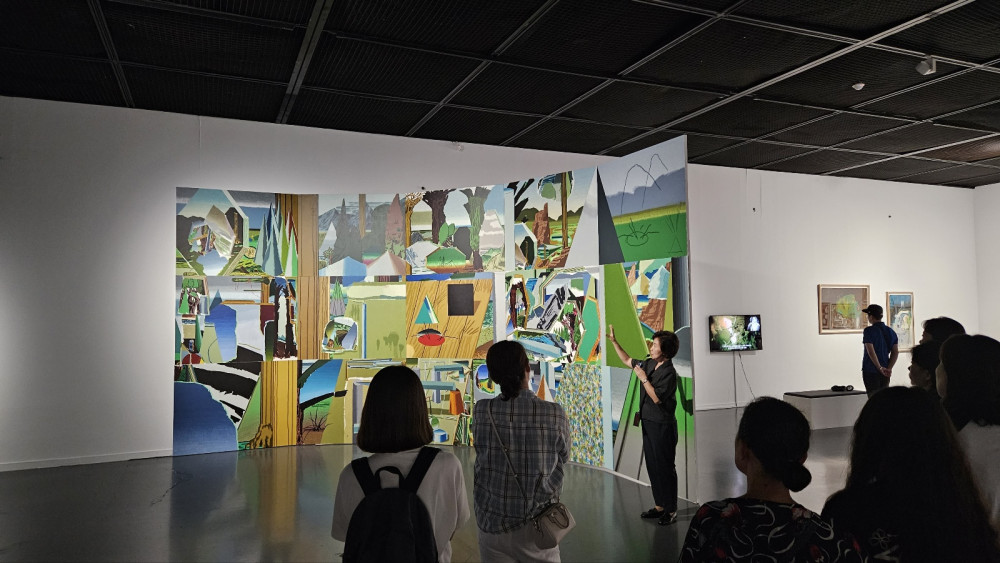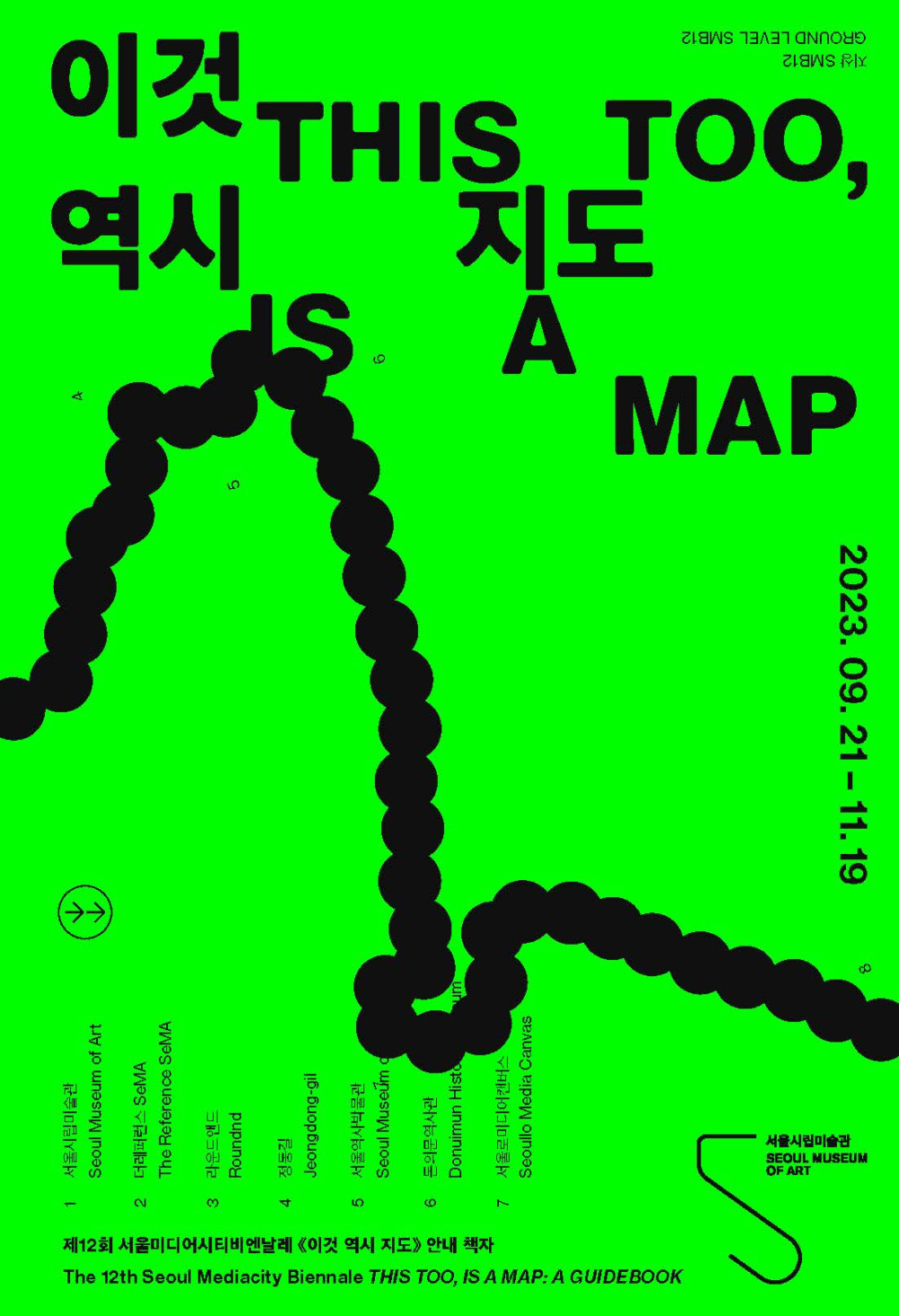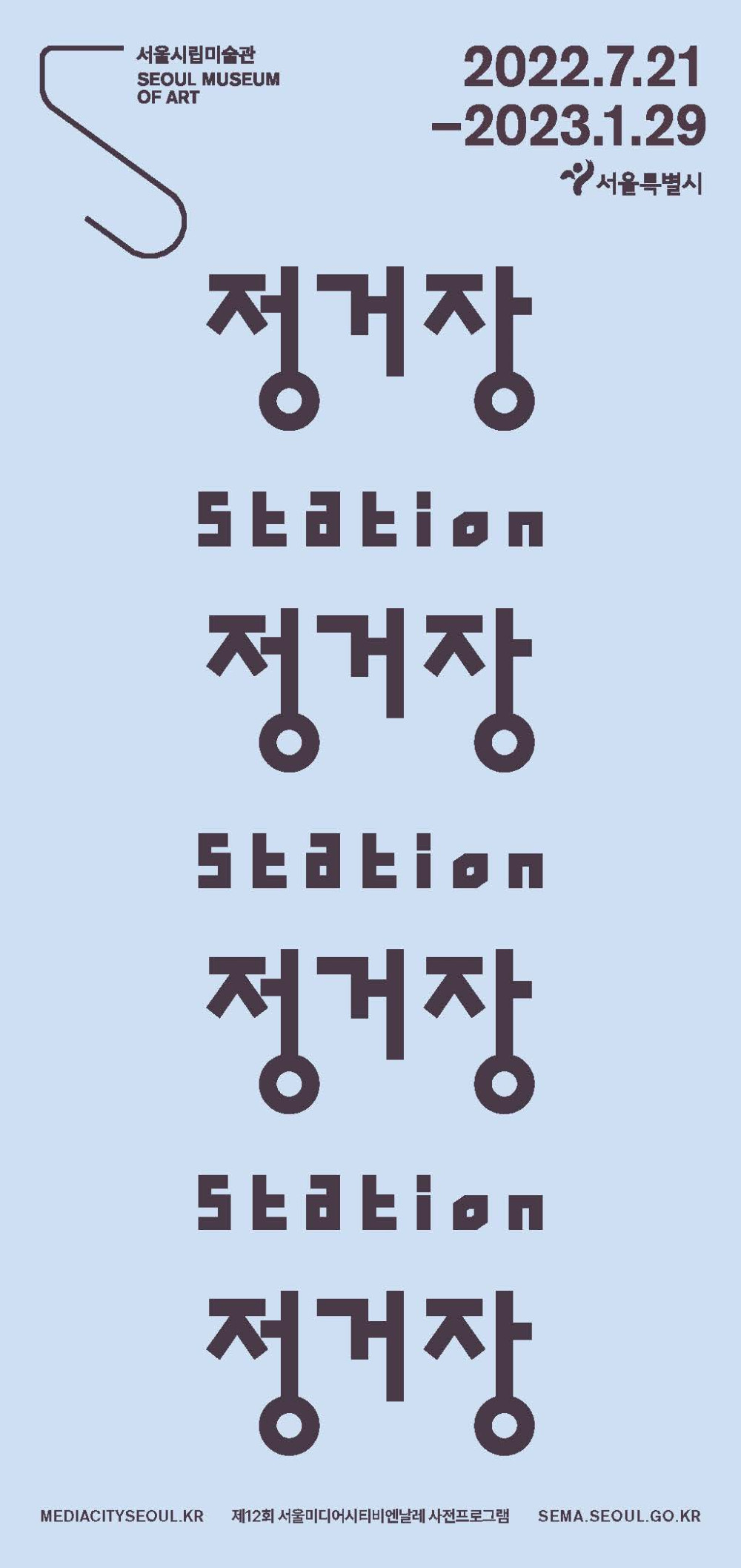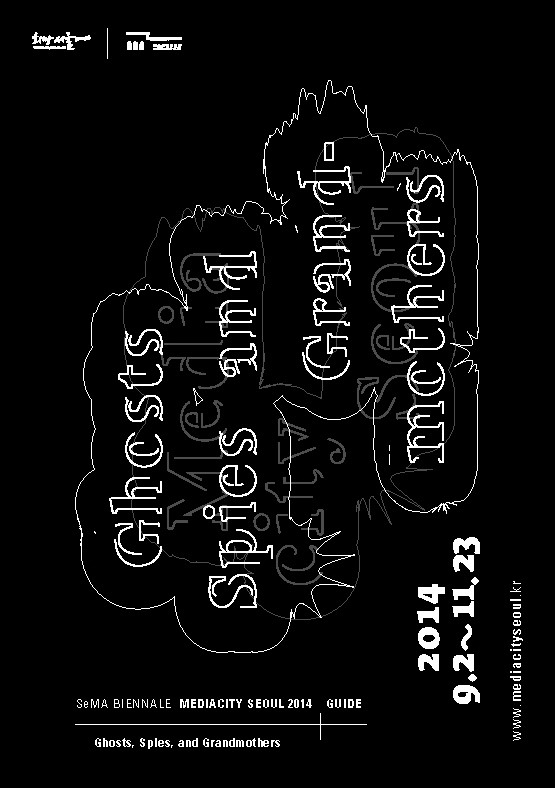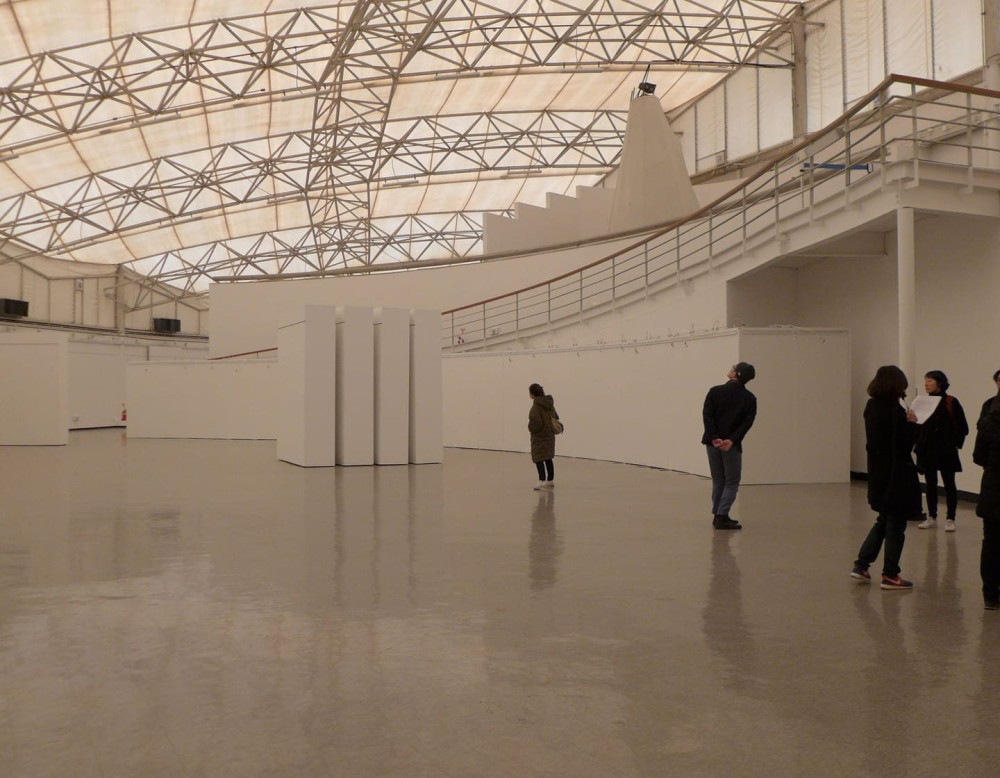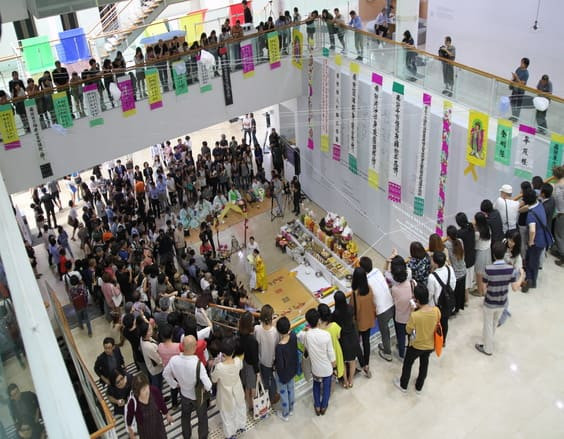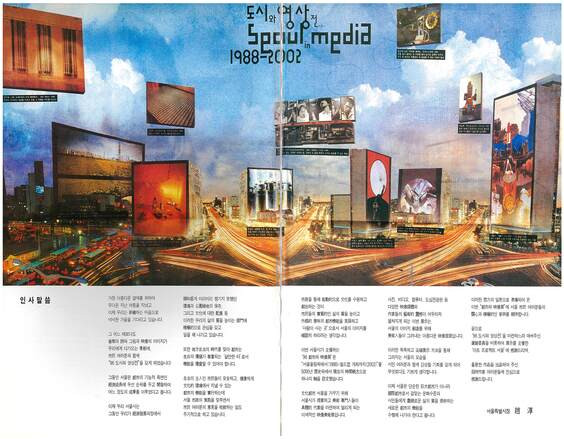Docenting: Mediation or Volunteering

This interview is a conversation with two Seoul Museum of Art docents who engage directly with audiences on-site, about the Biennale. It includes an edited transcript of the voice recording, related image materials, and the interviewees’ biographies.
After studying French language and literature at university, Park Kwijoo moved to Paris and spent five years completing a French cultural history program. After returning to Korea in 2004, her interest in contemporary art led her to become a docent at Seoul Museum of Art (SeMA). In 2006, Park obtained assistant curator certification and since 2013 she has taught in SeMA’s docent training program. She participated as a training instructor at Seoul Women’s Plaza and Jeju Museum of Art in 2019 as well as taking part in the Seoul Mediacity Biennale (SMB) advisory committee in 2022.
Sungwoo Lee studied business in graduate school and began working at a Korean company in 1985. He lived in China from 2001 to 2006 and subsequently spent four years in the United States. Later, he taught marketing-related courses at a Korean university for eight years. Building upon the memory of exhibition guide programs that he experienced at art museums overseas, he worked as a docent at the Nam June Paik Art Center from 2010 to 2017 and has been serving as a docent at SeMA since 2011.
Research Title Docenting: Mediation or Volunteering
Category Interview
Edition The 13th Seoul Mediacity pre-Biennale
Participants Park Kwijoo, Sungwoo Lee, Seoul Mediacity Biennale Office
Korean-English Translator Barun
English Copyediting Andy St. Louis
This interview series focuses on editions of the Seoul Mediacity Biennale (SMB) held during the past decade, documenting the experiences of experts who have created new roles in the shifting contemporary art scene. Despite the frequent criticism that SMB is difficult for the public to understand, docents serve as both mediators and messengers who communicate directly with the audience. This interview with two SeMA docents reflects on the concept and practice of “participation” in contemporary art.
SMB Generally, exhibition commentators are referred to as mediators or exhibition tour guides, but the term ‘docent’ seems to be used more commonly in Korea. How and when did you begin working as docents? What sort of qualifications or preparations are required to become a docent at SeMA?
PARK KWIJOO (PARK) I stumbled across a recruitment notice for foreign language docents on the SeMA homepage. The museum was targeting speakers of French, English, Chinese and Japanese, as if recruiting interpreters. I was interested in contemporary art and had recently returned from France, and I decided to apply for the program since it seemed like an opportunity to use my foreign language skills. After becoming a docent, I’ve actually only used French once, when I was leading a group of French professors.
I started working as a docent at SeMA in December 2004 after receiving docent training earlier that year. The first exhibition I took part in was SMB03 Digital Homo Ludens (2004). At that time, individual docents weren’t assigned to the entire Biennale; instead, each floor of the exhibition had its own docent who would lead visitors to the next floor’s docent. I remember there was great confusion one time when the docent in charge of the second floor was late.
SUNGWOO LEE (LEE) Beginning in 2006, I worked at a company near San Francisco, USA for about four years. On weekends, I enjoyed seeing contemporary art exhibitions at the de Young Museum or SFMOMA. I used to paint as a hobby and my wife also graduated from an art university. Whenever I visited art museums overseas, I was impressed by the old ladies who dressed nicely and explained exhibitions using simple English for easier comprehension. To me, it seemed like a good type of volunteer work that one could enjoy doing at an old age, so I started to attend guided exhibition tours from time to time. As soon as I returned to Korea, I went to the Nam June Paik Art Center and found out they were looking for docents. I applied and have been working as a docent since then. Nam June Paik Art Center mainly exhibits art installations or video art but I was more interested in paintings, so when I learned that SeMA was recruiting docents I applied and started working here. I had to take an exam to become a docent, but I was happy that I could study contemporary art through docent training.
PARK Back then, prospective docents had to attend eight to ten lectures after registration, followed by a separate application to take the docent exam. The first phase of the exam was a written test and the second phase consisted of an interview and a presentation (mock guided tour). Nowadays, however, the competition is greater and the recruiting process has changed. I heard the written test is more difficult now, which means that we would probably fail the exam if we had to take it again.
SMB How many editions of SMB have you experienced while working as a docent at the museum? Are any of these particularly memorable, and if so, why?
LEE I first worked as a docent at the museum in 2011 and led guided tours for SMB07 (2012), SMB08 (2014), SMB09 (2016) and SMB12 (2023). I didn’t work for three or four years during the COVID-19 pandemic, but I restarted my activities as a docent in 2023.
PARK I think I’ve experienced a total of eleven editions of SMB, including SMB12 pre-Biennale Station (2022). SMB11 One Escape at a Time (2021) was held with a modified schedule due to the COVID-19 pandemic, so I wasn’t able to do any tours on site, even though I received all the relevant training.
Every edition of SMB is memorable for me because each one is unique. In SMB03 Digital Homo Ludens (2004), Marina Abramović presented a video performance titled Light / Dark (1977) in which she and her partner Ulay slapped each other’s cheeks, which was shocking to me. I will never forget witnessing that piece. More recently, at SMB12 THIS TOO, IS A MAP (2023), Chan Sook Choi’s video THE TUMBLE (2023) was extremely touching and left a strong impression. The artist not only included beautiful writing about migration, but her video production itself also resonated deeply with me. In the same gallery, four videos comprising Francois Knoetze’s Core Dump (2018-2019) were very intriguing in terms of exploring the unbalanced relationships surrounding electronic waste. I don’t tend to watch a lot of video works, but I really enjoyed these, especially Core Dump: Dakar, which features a speech by Léopold Sédar Senghor, who was a poet and the first president of Senegal. I thought this work was impressive because such an archival recording was a rare find despite its short length. Also, I think SMB12 pre-Biennale Station (2022), held at Nam-Seoul Museum of Art, was a meaningful exhibition that reviewed the identity and history of past editions of SMB. It was interesting to see artworks from the early Biennales, which stimulated interest from all age groups. For instance, City Waterfall (1996/2022) by Hong Soon-chyul was praised as a brilliant idea by young audiences and a photo sculpture by Lee Kyuchul was always a favorite among visitors. Still images of City Waterfall were also displayed on the media board outside the building, but unfortunately they attracted relatively little attention because they were more difficult to spot, unlike similar public art projects in Gwanghwamun or on city billboards.
I also remember during SMB07 Spell on You (2012), there was an artwork on the third floor of the museum that most docents didn’t talk about because it was broken every time there was a guided tour. One day, when I led my tour group past the work without saying anything, the artist happened to be standing there. The artist got upset and asked me why I didn’t stop and talk about his artwork, making me really flustered. I shared this anecdote on the docent blog and other docents replied that they had similar experiences whenever the artist was on site. I think the artist was living in Korea at the time and visited the exhibition daily during the opening days of SMB.
LEE To me, SMB08 Ghosts, Spies, and Grandmothers (2014) was the most memorable. In short, it was my first opportunity to think about things that I hadn’t previously considered to be art. Artistic director Park Chan-Kyong’s works and his edition of SMB expanded the art world that I knew, much the same as Nam June Paik’s earlier attempts. SMB08 contained a lot of religious materials such as photos and videos that were traditionally considered taboo in Korean Christianity. I myself was raised in a Christian family, so I was also predisposed to classify things like shamanism, superstitions, folk ritual ceremonies as heretical. Seeing artistic interpretations of such cultural belief systems stimulated a lot of new ideas for me. Even among the audience, there were considerable responses of surprise and shock at the time.
SMB While preparing to welcome visitors, docents are permitted see the exhibition before anyone else, including during the exhibition installation period. Since SMB is always busy event with lots of new artworks, you must have encountered all kinds of unfamiliar scenarios such as finding discrepancies between information you received beforehand and the actual artworks installed in the exhibition hall.
PARK Since every edition of SMB includes many foreign participating artists, it takes extra time for docents to prepare their commentaries. The museum provides basic information, but each docent also does their own research ahead of the exhibition opening. If there are several new video works that haven’t been previously released, it can be difficult for the docents because they must view all the works and write their scripts within a limited timeframe. However, most docents seem to think of SMB as a special event or a festival and they are eager for the opportunity to come into contact with artists or artworks that they wouldn’t otherwise experience. I usually volunteer for early guided tours and I sometimes visit the galleries before the exhibition has been fully installed, although I am always careful not to interfere with the installation process.
I met the South African artist Kemang Wa Lehulere in the exhibition hall while I was preparing for SMB09 NERIRI KIRURU HARARA (2016). Wa Lehulere’s work Another Cosmic Interluded Orbit (2016) was a large chalk mural installed in the lobby of SeMA. Since it was a new piece , detailed information about it was not available prior to the opening. Thankfully, the artist was on site installing the work and when I asked him about the meaning of the fingers that appeared in one section of the mural, he explained in detail that he had used English sign language to draw dates related to uprisings or protests in South African history, as well as dates significant to his family history. Perhaps because I didn’t seem to understand or quickly respond, a busy coordinator working nearby helped to interpret the artist’s commentary, including a specific date that he mentioned. However, when I went home and looked up the date, I couldn’t find anything. After thinking about it a little more, and I guessed that some dates might not be searchable on Google due to political sensitivity. I was able to find a couple of dates related to the Soweto uprising, but I didn’t encounter any detailed explanations and even though I didn’t search any journal articles, I assumed it was one of those dates.
LEE In the opening days of SMB, more experienced docents usually do the guided tours. Information about the exhibited artworks, especially new works, is scarce during those days and it’s daunting to be responsible for commenting on an artwork that you’re not familiar with. In order to introduce the exhibition as a docent, it’s necessary to see all artworks from beginning to end, but sometimes this is impossible. I think that if the guided tours are scheduled within one week after the exhibition opening, or if there are too many people crowded inside a limited exhibition space, it might be better to suspend the guided tours.
SMB The museum usually offers docent training and provides materials for exhibition commentaries during the opening of SMB. Is it true that some docents also ask questions or give additional explanations if they have already done their own research on the participating artists and artworks?
PARK It depends on the individual, but a big part of working as an exhibition commentator is studying the materials provided by the museum. If those materials are delayed, you can still prepare by learning the names of participating artists and reading previously published articles about the main artists in the exhibition or its overall theme. There’s also an online training session with a curator and an offline tour of the exhibition a few days prior to the opening, both of which are easier to understand when you’ve already done considerable research.
LEE It’s practically impossible to get all the information through the tour. That’s why we prepare in advance.
PARK When you see the works installed in the exhibition hall, sometimes they are much bigger or smaller than you originally thought, or you realize that it’s better to comment on a different work than you had originally included in your script. There’s also the issue of tour routes. When selecting works to include in your docent commentary, it’s essential to visit the exhibition site. Research itself can be done at home, but specific factors such as how a certain artwork operates can only be verified on site.
LEE Although it doesn’t happen often, sometimes an artwork that is included in the exhibition overview but ends up being omitted in the actual installation of SMB. For example, you might only see two works by an artist when there were supposed to be three.
SMB Does each docent create their own tour route and select the artworks to include in their commentary? Or are there universal guidelines?
PARK Most docents select works after hearing which ones the curator emphasizes during the docent training. In terms of routes through the exhibition, unless there are explicit guidelines, each person is free to choose their own path. Usually, docents who lead tours during the opening days of SMB serve as references. If their tour routes aren’t particularly strange, other docents tend to generally follow their lead. However, each person speaks at their own pace and in their own style, so the content and length of their commentaries will vary. I think I speak at a slow to medium speed, so I try to be concise in my explanations. In terms of selecting artworks, as long as you do the research, the works that most docents consider to be important are usually similar. Things might be a little different nowadays, though.
LEE To add one more thing, there’s always a chance that a certain artwork doesn’t resonate with you or is particularly difficult to understand. I tend to not include such works in my docent commentaries. I’m the kind of person who needs to talk about what I see and feel rather than reciting something that I have memorized in advance. In that regard, it seems that each docent comments on various artworks according to their individual preferences. In the case of SMB, it’s wise to plan out a number of options for your tour route. That way, if a certain section is too crowded you can decide to exclude it on the spot, or if a video has ended right as you arrive at the work, you can return to it later after introducing other works first. You can also ask for the visitors’ understanding and suggest viewing alternate artworks. That’s how we create options and plan our paths. It’s difficult at first, but you pick up the necessary skills as you become more experienced. On the other hand, I also try to include works that people might not be interested in, particularly if I feel that they connect with things that I want to discuss. This was the case at SMB12 THIS TOO, IS A MAP (2023), with Mouth to Mouth (1975) by Theresa Hak Kyung Cha (1951-1982), who passed away in New York. I had come to learn about the artist before SMB because my daughter, who was studying English literature, had asked me to buy her a book about Cha. At SMB, however, Cha’s work was small in scale and displayed without any information, so a lot of visitors just passed by without paying much attention. That’s why I intentionally included her work in my tour.
SMB One of the important characteristics of SMB is its function as a hub of international exchange. Sometimes artworks that people in other countries readily understand or emotionally relate to may feel very strange or unfamiliar to a Korean audience. Have you experienced instances of excluding artworks from your guided tours due to such issues?
LEE Torkwase Dyson’s work I Belong to the Distance 3, (Force Multiplier) (2023) in SMB12 THIS TOO, IS A MAP (2023) could be considered such a case. It was a large installation work positioned at the entrance of the exhibition, and although I listened to the curator’s explanation during the docent training, it was quite difficult for me to understand. Those kinds of works are challenging. I remember feeling angry after reading an unrelated interview in which a journalist said that a certain artist’s work was difficult to understand, to which the artist replied that if they were to look at the work for three days, the work would speak to them. I mean, realistically, who can look at an artwork for three days? I try to look at works for a long time and think about them, but there are some artists who aren’t particularly friendly. Works that aren’t explained well by the artist are more difficult because of the lack of information. That’s why whenever you are able to think of something to say, it feels good. Since everyone has different preferences and standards, I might not understand some works that are appealing to other people. Not everything feels beautiful or meaningful and nothing is standardized, so I think being able to develop your own interpretation is part of the fun of enjoying contemporary art. I hope my opinion on this topic is understood from that perspective.
PARK As for me personally, I don’t skip over any artworks just because they are difficult. If I feel that the piece is good, I try to explain it to the best of my ability. Tomorrow Everything Will Be Alright (2010) by Akram Zaatari at SMB07 Spell on You had a poetic title and I appreciated the atmosphere it conveyed more than its actual content. The work mentions a green ray, which reminded me of an old movie titled Le Rayon Vert (The Green Ray), so the artwork felt very sentimental to me.
LEE A good thing about being a docent is being able to view the same artworks for extended periods. It’s not easy to encounter an artwork twice, no matter how much you enjoy it, but when you are a docent you can see things again and again.
SMB As mentioned earlier, the content of a docent’s tour is subject to change depending on the circumstances inside the exhibition hall such as ambient noise, viewing time, special conditions and even the type of media or installation methodology. What factors do you consider in order to introduce a wide range of works with diverse characteristics while not interfering with the other exhibition visitors?
PARK I pay extra attention when preparing my script. If my script solely focuses on the works I plan to discuss, I end up feeling nervous. So I prepare three or four spare scripts and I make sure to include additional works that I don’t intend to cover, just in case I need to adjust my tour due to an unforeseen issue such as an artwork being temporarily unavailable on site. It’s also helpful to have some flexibility in terms of adding or deleting sections of my script as necessary. In the case of a long video work, for example, I may plan to talk about a certain scene but if that part is not playing at the moment I bring my tour to view the work, I can’t just wait around indefinitely so it’s better to be able to make adjustments. And keeping in mind that we shouldn’t bother other visitors, whenever someone is blocking the view of a particular work, I ask for their understanding either verbally or with gestures. I do this to avoid causing them to leave or feeling annoyed when hearing a docent’s commentary right next to them. Such an experience can leave a negative impression or uncomfortable memory for visitors, so I try to be careful.
LEE In similar situations, I also tell people, “I am going comment on this artwork, and you can listen as well if you want.”
PARK No matter how big the exhibition is, visitors start to get tired if the guided tour lasts for more than 50 minutes. Even with SMB taking up all the floors of SeMA’s Seosomun Main Building, I think tours should be capped at 50 minutes. Recently, the museum has hosted several special exhibitions and docent tours that varied in length from 30 minutes to 50 minutes. Visitors might think that a longer tour would be better, but the museum decided that tours shouldn’t take more time than necessary and suggested adjusting the average tour duration. Now, the suggested durations are 30 minutes for an exhibition on a single floor, 40 minutes for two floors and 50 minutes for all three floors. Even with these guidelines in place, however, I don’t think basing such standards purely on the exhibition size is always appropriate. In some cases, an exhibition that only takes up one floor of the building may require 50 minutes to deliver the minimum amount of information. No matter what, conveying a lot of information within a limited time frame means that the docent has to rush through their commentaries, which can interfere with the quality of the tour. I think these kinds of issues are what docents need to work on.
In the past, there were many instances when visitors would suddenly interrupt a tour or disrupt the docent’s flow. One time, a male visitor who frequently visited the museum suddenly raised his hand in the middle of my tour to ask, “How many docents serve at SeMA?,” which was completely irrelevant.
LEE In my case, I try to be the one asking questions to the audience. About five minutes before starting a tour, I ask things like “Have you browsed the exhibition yet?” or “Do you come to the art museum often?” That way, I can determine the extent to which my group may already understand the exhibition or artworks.
SMB Docents have more opportunities to meet the audience face to face and receive direct feedback than the curators of SMB. The visitor demographics of SMB are more diverse compared to other biennales due to its free admission. Tour guide programs likely attract a wide range of participants including art experts, art enthusiasts and general visitors, each with corresponding levels of knowledge of contemporary art and biennales. Are there any special considerations that you take into account when preparing or presenting docent tours?
LEE When it comes to the visitors who join guided tours, I think that they mostly do not have a deep understanding of contemporary art. As for the demographics, SMB is known to attract many young visitors, but I have seen visitors of various age groups on site.
PARK I think SMB has a fixed audience of people who always make sure they don’t miss it. While early editions of SMB were centered around high-tech artworks, the types of media have increased in recent years. However, the age range of visitors doesn’t seem to have widened in correlation; instead, I think the SMB audience is rather loyal and looks forward to taking part in each edition.
LEE Supposing there are ten participants in a guided tour, I think the docent should cater to the level of about 60-70% of those people. Guided tours are different from audio guides or mobile apps in that they allow for eye contact with the audience as well as bidirectional communication. The content of a tour can be adjusted to the participants’ level, which is the benefit of the docent’s role. In my experience, art experts don’t take part in guided tours. But even if they did, they wouldn’t reveal their expertise or identity. Most participants are general audience members plus a few art enthusiasts. I find that people usually make a decision after listening to the first part of the tour; if they want to continue listening they stick around, but if not they leave about halfway through. People who listen carefully to the docent’s explanations probably don’t have a lot of prior knowledge. Therefore, I think it’s important to discuss things that can be understood easily rather than making things too complicated. If participants ask questions about topics that are beyond the scope of my commentary, I try provide answers as best I can. I usually arrive early and since the museum doesn’t offer a separate guided tour in English, I sometimes approach if I foreigners who are visiting the exhibition and offer to explain things. I do such things voluntarily if the situation organically allows it.
SMB According to an audience survey report in 2023, there was an expert group as well as a small portion of loyal audience members who regularly attend SMB, although the majority of the audience comprised regular museum visitors. Whenever the museum itself is flourishing, SMB also enjoys more visitors, so these figures are connected. As many Korean art institutions have claimed , the largest demographic group of SMB visitors consists of women in their 20s and 30s. Perhaps there are ways to attract a broader spectrum of attendees in the future, in terms of their age and background?
LEE When I returned to working as a docent after taking three or four years off during the COVID-19 pandemic, I noticed a slight shift in audience demographics. Recently, I’ve spotted couples visiting during the morning hours, which was very rare in the past, and visitors my age and older are also coming to the museum. I guess Baby Boomers are beginning to visit the museum in greater numbers as they retire. If SeMA is able to recognize these changes and cater to other demographic groups, I think it could expand its audience further.
PARK I agree. Nowadays, there are even docent couples who attend each other’s guided tours. That kind of thing didn’t happen before. It’s also common for a docent’s family to visit the museum together so they can take the guided tour and give feedback.
LEE SeMA seems to be a good place for family outings because there are so many restaurants in the neighborhood as well as a palace nearby.
SMB Since the COVID-19 pandemic, exhibition environments have changed dramatically and tour guide programs have diversified. Mobile docent apps, QR codes and guide services that rely on devices are now being readily utilized. The style of viewing in which individual visitors walk through an exhibition while listening to an audio guide through headphones is encouraged, as opposed to the traditional format of guided tours where visitors move together in a group. How do you respond to these paradigm shifts in the exhibition environment?
PARK For large groups of visitors, it makes sense to provide exhibition commentaries through an app. But your ears can get tired after listening to headphones for a long time and the language used in the audio guide app tends to be literary and formal. In those aspects, there’s still a need for in-person guided tours. I heard that people tend to use the app if the tour schedule doesn’t align with their visit to the museum. It is supposedly difficult to increase the number of guided tours due to administrative issues, but hopefully these issues will be resolved.
LEE Especially for English commentaries, I recommend using the app. It seems hard to find docents who are fluent in both Korean and English.
PARK There used to be English-speaking docents at SeMA. The museum recruited and trained a group of foreigners who worked alongside the other docents for about a year.
LEE The biggest benefit of guided tours is communicating directly with the audience. I think we need to have guided tours that are flexible so we can answer questions on site and provide simple explanations. Even though docents study the artworks, sometimes they skip works that they don’t know well, right? On the audio guide app, however, famous actors often narrate scripts written by a curator or writer rather than using their own words, which can make their commentaries more difficult to understand.
PARK These days, device users seem to take the spotlight on social media and whatnot, but inside the exhibition hall itself there actually are far more visitors who prefer guided tours by docents. These people are predominantly absent from the online landscape, since older people don’t actively use social media or blogs, so their opinions or responses are basically ignored. Other than the audio guide app, I also like when the museum provides a free printed guidebook containing the exhibition overview and information about individual artworks. There were positive responses from visitors about free guidebooks as well. If you browse through materials provided by overseas art museums, they typically offer more diverse services in foreign languages than you might expect. It’s almost enough for studying a foreign language. With so much available information and practical resources, people today can experience another museum’s artworks without traveling to a foreign country.
SMB It’s clear that there is no substitute for the distinctiveness and benefit of in-person guided tours. According to the aforementioned audience satisfaction survey, docent tours received the highest score in terms of communication and level of understanding. Is it common for docents to give feedback or evaluate each other’s tours?
PARK Script preparation is usually done individually. Once the tour programs begin, docents make revisions based on their own experiences and audience responses. I think most of us listen to other docents’ commentaries for the first week after the exhibition opens before starting to make revisions. Through this process, we can share things that we might have otherwise missed or failed to research. Nowadays, we’re expected to submit our scripts to the museum curator in charge of training five days before tours begin, or within three days of the exhibition opening. This allows the curator to read all the scripts and give feedback as necessary.
LEE When I first started working as a docent, I practiced in front of my wife. But now the museum provides sufficient resources, so there I have no problems preparing.
SMB Recently, accessibility has become an important issue both online and offline. Various attempts are being made by SeMA to address this concern, including sign language guides and easy-read guides. What are your thoughts on this topic?
PARK When it comes to wall text, viewers find it difficult to read small fonts and it’s best to position these texts at eye level. In terms of the easy-read guides, I sometimes doubt whether they are actually easier to read than normal text. On the other hand, the docents playfully complained among ourselves that if all artworks are explained this way, there would be no reason to offer guided tours. But even if easy-read guides and other accessible resources are available, audience members don’t read everything. It’s possible to selectively read texts here and there, but most people aren’t very enthusiastic about reading. I think it’s more important to stick to the basics and make things easy to see by adjusting the lighting or font size.
LEE I would like to carefully voice my opinion. To consider priorities with respect to accessibility, even before thinking about docent commentaries, the exhibition space should first and foremost be large enough to allow for comfortable viewing by disabled visitors. Otherwise, even if you add large captions, easy-read guides, sign language videos and barrier-free structures—all of which are meaningful measures—it still begs the question as to whether these are practical solutions to real-world accessibility challenges. Above all, the exhibition hall must be spacious in order to ensure ease of access, not to mention that basic transportation issues must also be resolved. I don’t know if the museum’s steps forward on its own would have any significant impact.
PARK I recently led a guided tour of an exhibition on the first floor of SeMA’s Seosomun Main Building and there was a visitor in a wheelchair in my group. I was a little concerned, so I asked if he would be okay with the speed of my tour. He seemed to be familiar with situations like this and he took a spot in the front of the group so he could freely move ahead. But as I continued the tour, I noticed him arguing with someone next to him about his spot. As was the case in this story, I think that the basic infrastructure for viewing art should be prioritized, yet I feel a little discouraged when I see accessibility being emphasized in superficial ways. In other countries, they enact additional measures beyond the basics that are already in place, but in Korea I think it will take time for these things to change.
SMB Do you have any suggestions for improving the docent programs based on your experience in areas such as scheduling, target audience, reservation method, etc.?
PARK Visitors often ask me if more guided programs can be added.
LEE In previous editions of SMB, we scheduled two guided tours per day, which was reduced in 2023 to one tour per day. This change was probably caused by internal factors such as reduced budget. But docent tours are ultimately a public service. During one edition of SMB, docents received exhibition catalogues from the museum. I think there are several ways to motivate more docents to participate, such as substituting the docent’s pay with exhibition tickets or souvenirs.
PARK It seems that interest in docenting has increased in the past few years, to the point of oversupply. The number of participating docents has increased while the number of programs has decreased, leading to a decrease in individual docent participation. For example, during a recent exhibition, I led a total of just three guided tours. I was fortunate to be able to participate, but I felt that the number of tours was too low compared to the amount of time I had invested in preparing. Among the docents, some people have suggested that we should each participate in fewer exhibitions but increase the number of tours we lead per exhibition. I believe that if there are more guided tours, complex problems could be resolved.
I don’t think the museum can improve the way that it provides us with materials. But when it comes to video works, I wish we could preview them beforehand. If the work itself is difficult to understand, it doesn’t really matter how much information we have; we can only explain as much as we understand. These days, there are also discussions about dividing docent programs into different audience groups, which I think is a good idea. There are times when the pace or route of a tour needs to be adjusted based on the needs of the participants such as children, seniors or group visitors. I think it would also be effective to offer an overview of the exhibition in a lecture room prior to each tour, followed by seeing a selection of significant works in the exhibition space.
LEE Nam June Paik Art Center had guided tours for children, but children’s language is different. Maybe if the children could watch videos in a lecture room first and subsequently move on to the exhibition hall to experience works directly, I think they would understand better. Another idea is to feature artworks from SMB that are easy for the general public to grasp. Of course, this has to be the curator’s decision, but wouldn’t it reduce negative impressions of SMB if docents were to focus on familiar artists like Nam June Paik? Especially among young visitors, many people come to the art museum to take photos, both of themselves and of artworks, but I don’t think they actually think about the works they see. Personally, I’m not a fan of this activity, but it’s important to accept reality and I think we might need to cater to these visitors, whether by highlighting photogenic works or creating a photo zone.
I also think it’s a good idea to promote reservations for student group visits. Some teachers might be interested in SMB, and when we had a group visit from a high school during the previous edition, all the students loved it. It would be nice to encourage group reservations and schedule guided tour programs for that audience. It seems like this might be possible within the scale of SMB. Finally, operating guided tours during non-peak hours like 10-11 am on weekdays or 2 pm on weekends would both minimize interference with other visitors and promote safety.
SMB We ought to consider the audience’s perspective while also maintaining the unique identity and experimental spirit of SMB. If you could suggest some audience-friendly events or programs other than guided tours, what would they be?
PARK Audience members who are interested in contemporary art would probably be most curious to learn more about the participating artists. I think programs in which artists and audience members could meet in person would be nice. If possible, the artist could explain their own works, or something similar could be done online. While I was looking through some blogs, I found that there are also non-expert visitors who are fond of SMB itself. It would be interesting to create a program for compiling and presenting these people’s writings, reviews and photographs of SMB in connection with the exhibition.
LEE From a marketing perspective, we could divide the audience into two groups: those who possess considerable knowledge and experience in contemporary art, and those with no prior interest in contemporary art. For example, if a celebrity visits the exhibition, it would be worthwhile to target their followers with marketing for the purpose of attracting new visitors. On the other hand, for people who already have an interest in contemporary art, the museum could offer additional information about the exhibition and hold conversations with artists or educational programs. I suggest analyzing and approaching the two audience groups differently. Also, continuous media exposure is very important, either through viral marketing or inviting celebrities to the exhibition. I’m just speaking from an objective standpoint without any knowledge of the practical limitations, although I’m aware that there may be budget issues.
With respect to content, it would be helpful to post information such as specific screening schedules for videos with long running times. And in terms of exhibition layout, it would make more sense to connect external spaces with site-specific works rather than scattering artworks across too many locations. For SMB, I think the space itself is as important as the exhibition. The space should be pleasant, but the Seosomun Main Building is actually too small to create an agreeable exhibition. I think there need to be more considerations about the space.
SMB What do you think are the characteristics of SMB that distinguish it from other biennales?
LEE I think the setting of Seoul is significant. Seoul virtually encompasses and symbolizes the entire country of Korea.
PARK I purposefully haven’t visited biennales in other regions. SMB has a long history and now seems to be the right moment to solidify its identity. It’s crucial to pay attention to the issues that we’ve discussed so far and more actively utilize satellite spaces around Seoul, as was common in early editions of SMB. Through research, you could propose subway stations or other representative locations in the city of Seoul and use them in marketing materials to attract more interest. With every edition of SMB, I feel that sometimes an excellent exhibition fails to receive enough attention in the media. That’s also something to be analyzed.
LEE I’d like to add that in terms of the information that is released to journalists, emphasis on certain important points is equally important as the quality of the writing itself.
SMB The traditional role of docents seems to be changing as well. Now, docents are closer to being “mediators” that facilitate exchanges of ideas, conversations and discussions, instead of giving lectures or explanations solely for the purpose of relaying information. The audience interacts with the exhibition and its artworks through guided tours, with docents providing a window through which the audience experiences the exhibition, and together they form “a place of participation.” Before we close, please say a few words about your objectives as docents.
PARK Since docents are not exhibition curators, I think our job is to accurately deliver information about the exhibition. To me, the biggest issue we face is doing this a friendlier way. I try to make my explanations as simple and concise as possible, while being careful not to miss any important points. I don’t think delivering a lot of information is the same as accurately delivering the intent of the exhibition. Sometimes a docent’s emotions can come through in their explanations, but this should be avoided because it leads to preconceptions among the audience, especially young people. I think a docent’s explanations should always leave a room for the audience’s own interpretations. I try to summarize objective information and deliver it clearly, then leave the rest to the audience. Since every docent has their own personality and taste, some docents believe that the information they share must be as close to the right answer as possible. However, I believe that docents play the role of steering the audience in the right direction instead of simply providing answers. I try to avoid paying too much attention to or being swayed by the audience’s response, while also keeping my tours balanced.
LEE I agree. I begin my guided tours by talking about the exhibition theme and curator, and then I end with a specific artwork, although selecting this work can be challenging. In last year’s edition of SMB, I ended my tour by commenting on THE TUMBLE by Chan Sook Choi because its narrative of migration was a nice conclusion to my tour. Sometimes it’s difficult to select a final work because of the tour route. Even if I stray slightly from the exhibition theme in the middle of the tour, it is essential for the benefit of the audience to reiterate the general theme and purpose of the exhibition at the beginning and end of the tour. That is what I really focus on.
PARK When I first started working as a docent, I didn’t approach it as volunteer work. I encountered a friendly atmosphere and I had fun giving tours and having meals with other docents. On top of that, unlike other kinds of groups, I also learned things. (chuckles) When people ask me why I do this despite not being paid, I reply, “Just because.” I think other docents also do it just because they want to.
LEE I consider both exhibitions and art commentaries as aspects of social science. Contemporary art encompasses history, society, politics and economics, so we discuss such topics related to the humanities using artworks. I think people who are interested in such topics can experience the fun of contemporary art through guided tours. I used to introduce myself as a volunteer worker, but at a certain point I thought it started to sound awkward. This work requires study and experience, and it affords the pleasure of having conversations that are extensions of daily life.
PARK Since docents themselves derive personal satisfaction from it, perhaps this work doesn’t qualify as volunteering in a strict sense.
LEE Wouldn’t that be the most desirable and highest form of volunteering?
Interview Date: May 16, 2024
